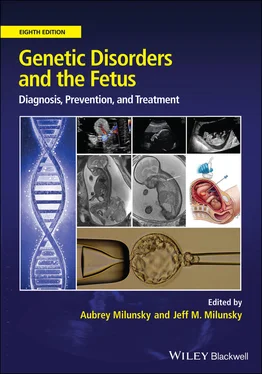Genetic Disorders and the Fetus
Здесь есть возможность читать онлайн «Genetic Disorders and the Fetus» — ознакомительный отрывок электронной книги совершенно бесплатно, а после прочтения отрывка купить полную версию. В некоторых случаях можно слушать аудио, скачать через торрент в формате fb2 и присутствует краткое содержание. Жанр: unrecognised, на английском языке. Описание произведения, (предисловие) а так же отзывы посетителей доступны на портале библиотеки ЛибКат.
- Название:Genetic Disorders and the Fetus
- Автор:
- Жанр:
- Год:неизвестен
- ISBN:нет данных
- Рейтинг книги:4 / 5. Голосов: 1
-
Избранное:Добавить в избранное
- Отзывы:
-
Ваша оценка:
- 80
- 1
- 2
- 3
- 4
- 5
Genetic Disorders and the Fetus: краткое содержание, описание и аннотация
Предлагаем к чтению аннотацию, описание, краткое содержание или предисловие (зависит от того, что написал сам автор книги «Genetic Disorders and the Fetus»). Если вы не нашли необходимую информацию о книге — напишите в комментариях, мы постараемся отыскать её.
Genetic Disorders and the Fetus — читать онлайн ознакомительный отрывок
Ниже представлен текст книги, разбитый по страницам. Система сохранения места последней прочитанной страницы, позволяет с удобством читать онлайн бесплатно книгу «Genetic Disorders and the Fetus», без необходимости каждый раз заново искать на чём Вы остановились. Поставьте закладку, и сможете в любой момент перейти на страницу, на которой закончили чтение.
Интервал:
Закладка:
Gordis et al. 201concluded that the way in which an obstetrician managed patients at risk regarding referral for genetic screening was closely related to that obstetrician's attitudes and education. Physicians in practice should be aware of the nuances and needs in the genetic counseling process, including the key psychologic aspects. 202Perhaps most important is the requirement that they recognize limitations in their knowledge of uncommon or rare genetic disorders and be alert to situations requiring referral. Obstetricians or family practitioners are not expected to have an extensive knowledge of all diseases but they should be able to recognize that a condition could be genetic. Concern about litigation should not act as a constant reminder to physicians of the need to consult or refer. 184 , 203 – 205
Ability to communicate
Many physicians are not born communicators and most have not had formal teaching and training to hone their communication skills. Recognizing these deficiencies, the American Academy of Pediatrics has provided valuable guidance and made specific recommendations for the development and teaching of communication skills, 206as have others. 207 , 208
Simple language, an adequate allocation of time, care, and sensitivity are keys to successful genetic counseling. Technical jargon, used with distressing frequency, 209is avoided only through conscious effort. How an issue requiring a decision is framed 210and the nature of the language used 211may influence the patient's choice. 212Counseling is facilitated when three key questions are asked: “Why did you come?” “What exactly do you hope to learn?” and “Have I answered all your questions and concerns?”
Although the explanation of exact statistical risks is important, patients often pay more attention to the actual burden or severity of the disease in question. How risks are explained and expressed is a skill to be mastered. Key to the exposition is the patient's educational level, cultural background, and the requirement of an interpreter (who may even bedevil a superb counselor). The use of numeric probabililties, relative risk, risk reduction or simple numbers of chance (1 in 100) or words (almost never, negligible, sometimes, more often than not) 213are choices a counselor must make. Clearly, the simpler the better and the more likely the information will be understood. Patients' perceptions of risk not infrequently differ markedly from those of the counselor, a realization that should elicit no comment. An essential ingredient of the counseling process is time. The busy practitioner can hardly expect to offer genetic counseling during a brief consultation. Distress and misunderstanding are invariable sequelae of such hastily delivered counseling.
Knowledge of ancillary needs
For the couple at high risk of having a child with a serious genetic disorder, prenatal diagnosis is not the sole option. Even in situations in which a particular disease is diagnosable prenatally, it is important to be certain that other avenues are explored. Prospective parents who are known, for example, to be carriers of an autosomal recessive disorder may be unaware of the possibility of sperm or ovum donation, or may be unwilling to raise the question. This option may be viewed more favorably than prenatal diagnosis and elective abortion. Physicians should be certain that their patients are familiar with all the aforementioned important options, as well as with adoption, vasectomy, tubal ligation, treatments of the mother and/or fetus during pregnancy, and other methods of assisted reproduction (e.g. intracytoplasmic sperm injection, 214epididymal sperm aspiration, 215and preimplantation genetic testing) (see Chapter 2).
Empathy
Empathy embodies the ability to not only understand the perspectives and emotions of others but to communicate that understanding. 216 , 217Much more than the communication of risk figures for a particular disorder is required in the genetic counseling process. Warmth, care, sympathy, understanding, and insight into the human condition are necessary for effective communication. The difficulty of assimilating information and making rational decisions in the face of anxiety 218should be recognized and vocalized. Empathy and sensitivity enable the counselor to anticipate and respond to unspoken fears and questions, and are qualities that make the counseling experience most beneficial and valuable to the counselees.
For example, a couple may have been trying to conceive for 10 years and, having finally succeeded, may be confronted by a callous physician who is impatient about their concerns regarding amniocentesis and elective abortion. Another couple may have lost their only child to a metabolic genetic disease and may be seeking counseling to explore the possibilities for prenatal diagnosis in a subsequent pregnancy or even treatment following prenatal diagnosis, as in the case of galactosemia. They may have in mind past problems encountered in prenatal diagnosis or may be aware of the uncertain outcome of treatment. Or worse still, after a long history of infertility, pregnancy is achieved only to find that the fetus has aneuploidy.
Sensitivity and awareness of the plight of prospective parents are critical prerequisites and include the need to recognize and address the usually unspoken fears and anxieties. They may have had a previous affected child with physical/mental deficits and experienced stigmatizing encounters, including intrusive inquiries, staring and pointing, devaluing remarks and social withdrawal. 219
Beyond the qualifications and factual knowledge of the counselor is the person who is key to successful and effective counseling. A compassionate attitude, body language, warmth, manners, dress, tone of voice, and personality are facets that seriously influence the credibility and acceptance of the counseling offered. Curiously, counselors rarely realize during their counseling session that they are simultaneously being assessed. Patients assess the apparent knowledge and credibility of the counselor, seek and are encouraged by evidence of experience, and consider the information provided in light of the counselor's attitude, body language, and other nonverbal characteristics. Staring at a computer screen while counseling conveys deep insensitivity and engenders no trust.
Essential prerequisites for the empathetic genetic counselor include the following:
Acknowledge the burden and empathize about the sadness or loss (e.g. a previous child; recurrent miscarriage; a deceased affected parent; a patient who has experienced mastectomy and chemotherapy for breast cancer with daughters at risk).
Vocalize the realization of the psychologic pain and distress the person or couple has experienced (e.g. recurrent pregnancy loss followed by multiple in vitro fertilization (IVF) efforts and subsequently a successful pregnancy with a fetal defect).
Acknowledge the coping that has been necessary, including the stress a couple might have to endure, despite sometimes conflicting feelings.
Recognize (and explain) psychologic difficulties in decision making when faced with a prenatal diagnosis of the same disorder affecting one parent (discussion of self‐extinction, self‐image, and issues of guilt and survival).
Fulfill the patient's need for hope and support and actively avoid any thoughtless comments 172that may erode these fundamental prerequisites. Well‐intentioned statements are frequently perceived in a very different way. 206
It is self‐evident that empathy would engender greater patient satisfaction and may well be correlated with clinical competence. 220
Sensitivity to parental guilt
Feelings of guilt invariably invade the genetic consultation. They should be anticipated, recognized, and dealt with directly. Assurance frequently does not suffice; witness the implacable guilt of the obligate maternal carrier of a serious X‐linked disease. 221Explanations that we all carry harmful genes often helps. Mostly, however, encouragement to move anguish into action is important. This might also help in assuaging any blame by the partner in such cases. 222
Читать дальшеИнтервал:
Закладка:
Похожие книги на «Genetic Disorders and the Fetus»
Представляем Вашему вниманию похожие книги на «Genetic Disorders and the Fetus» списком для выбора. Мы отобрали схожую по названию и смыслу литературу в надежде предоставить читателям больше вариантов отыскать новые, интересные, ещё непрочитанные произведения.
Обсуждение, отзывы о книге «Genetic Disorders and the Fetus» и просто собственные мнения читателей. Оставьте ваши комментарии, напишите, что Вы думаете о произведении, его смысле или главных героях. Укажите что конкретно понравилось, а что нет, и почему Вы так считаете.












